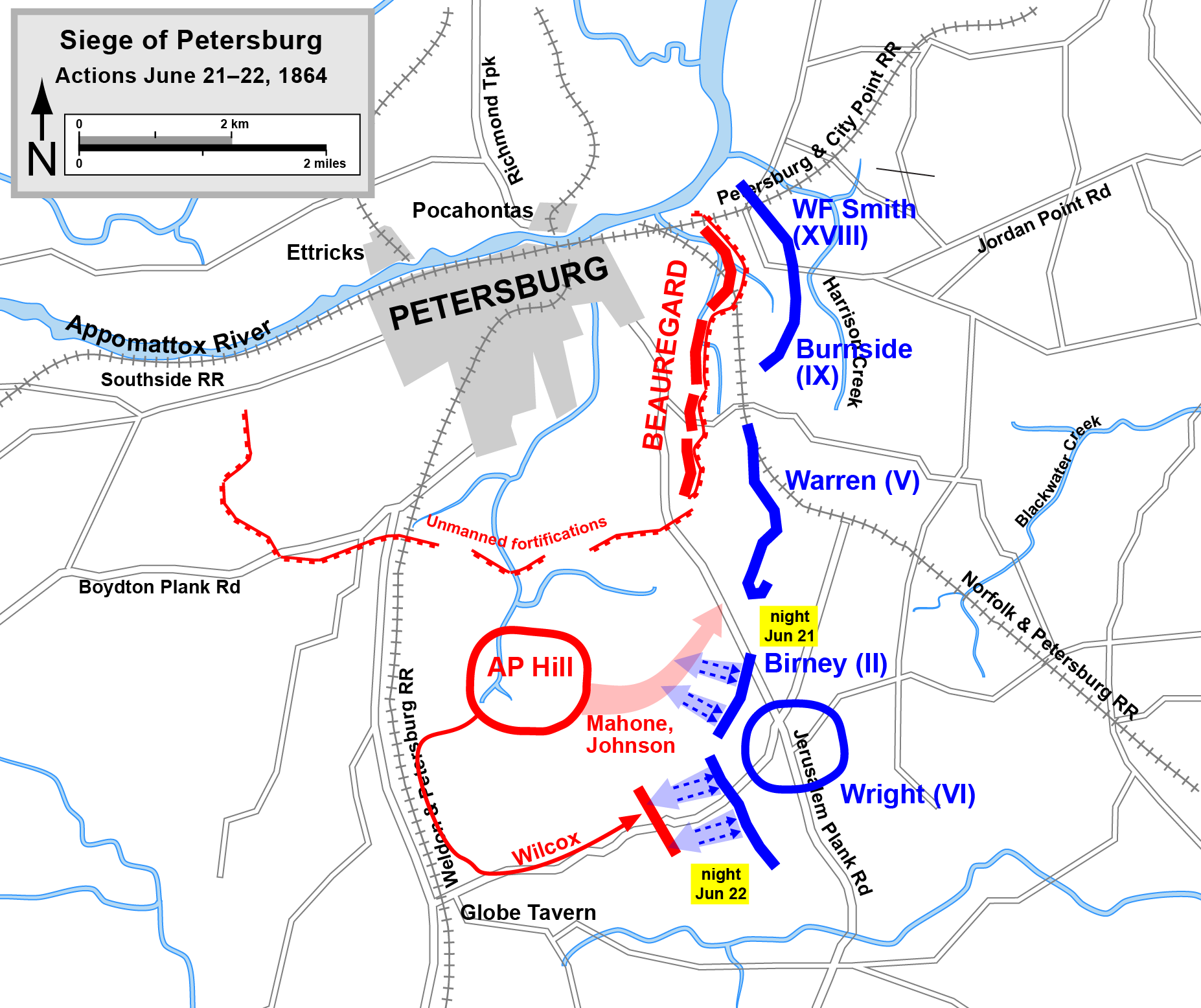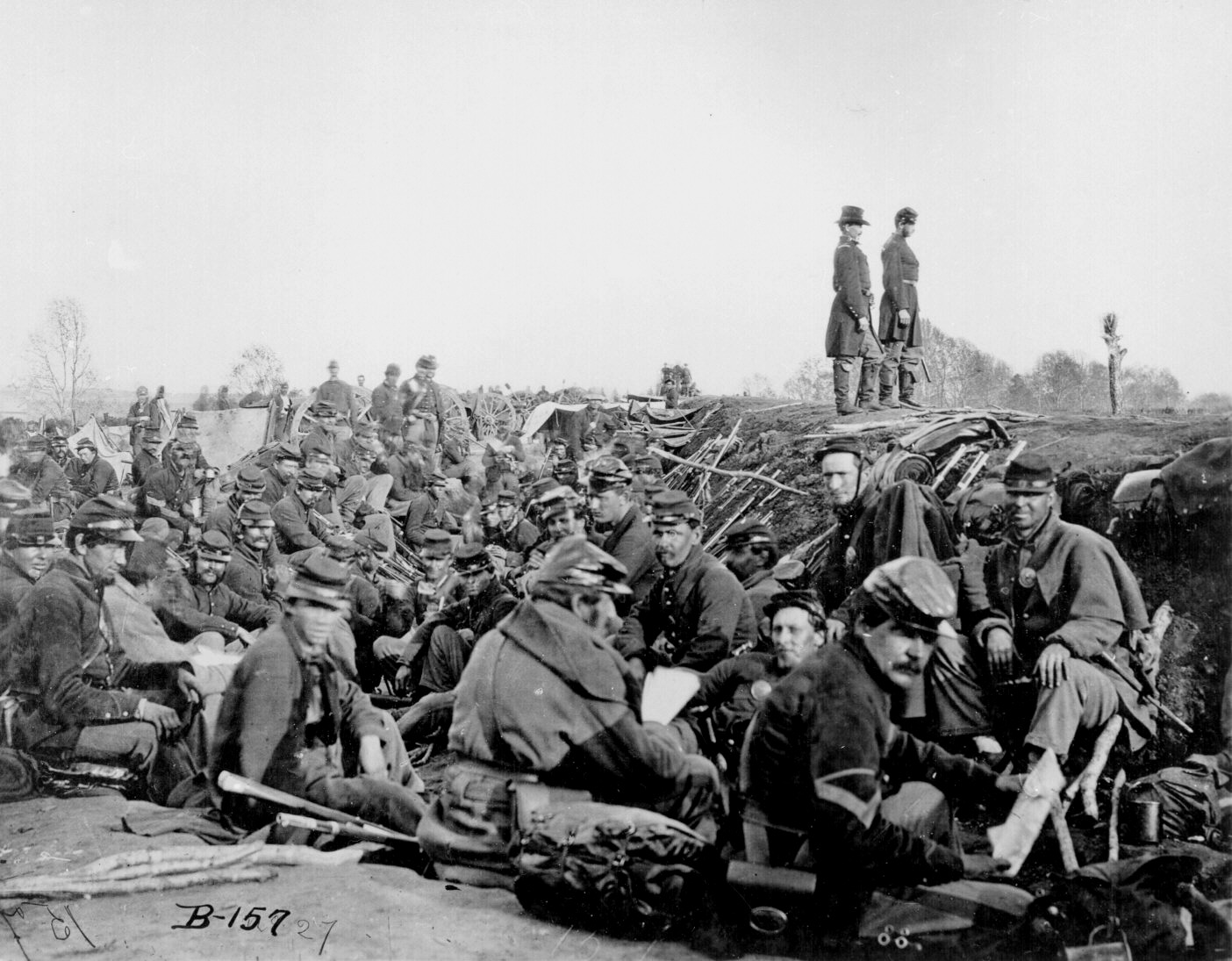|
Battery B, 1st Rhode Island Light Artillery
Battery B, 1st Rhode Island Light Artillery Regiment was an artillery battery that served in the Union Army during the American Civil War. Service Battery B, 1st Rhode Island Light Artillery Regiment was organized in Providence, Rhode Island and mustered in for a three-year enlistment on August 18, 1861 under the command of Captain Thomas F. Vaughan. The battery was attached to Stone's Brigade, Division of the Potomac, to October 1861. Artillery, Stone's (Sedgwick's) Division, Army of the Potomac, to March 1862. Artillery, 2nd Division, II Corps, Army of the Potomac, to June 1863. Artillery Brigade, II Corps, to June 1865. It mustered out of service on June 13, 1865. Detailed service Left Rhode Island for Washington, D.C., August 23. Duty at Camp Stone and along Upper Potomac until February, 1862. Operations on the Potomac October 21–24, 1861. Battle of Ball's Bluff October 21. March to Harpers Ferry, W. Va., February 25–26, 1862, and duty there until March 7. Moved to Charl ... [...More Info...] [...Related Items...] OR: [Wikipedia] [Google] [Baidu] |
United States
The United States of America (U.S.A. or USA), commonly known as the United States (U.S. or US) or America, is a country primarily located in North America. It consists of 50 U.S. state, states, a Washington, D.C., federal district, five major unincorporated territories, nine United States Minor Outlying Islands, Minor Outlying Islands, and 326 Indian reservations. The United States is also in Compact of Free Association, free association with three Oceania, Pacific Island Sovereign state, sovereign states: the Federated States of Micronesia, the Marshall Islands, and the Palau, Republic of Palau. It is the world's List of countries and dependencies by area, third-largest country by both land and total area. It shares land borders Canada–United States border, with Canada to its north and Mexico–United States border, with Mexico to its south and has maritime borders with the Bahamas, Cuba, Russia, and other nations. With a population of over 333 million, it is the List of ... [...More Info...] [...Related Items...] OR: [Wikipedia] [Google] [Baidu] |
Battle Of Sayler's Creek
The Battle of Sailor's Creek was fought on April 6, 1865, near Farmville, Virginia, as part of the Appomattox Campaign, near the end of the American Civil War. It was the last major engagement between the Confederate Army of Northern Virginia, commanded by General Robert E. Lee and the Army of the Potomac, under the overall direction of Union General-in-Chief Lieutenant General Ulysses S. Grant. After abandoning Petersburg, the exhausted and starving Confederates headed west, hoping to re-supply at Danville or Lynchburg, before joining General Joseph E. Johnston in North Carolina. But the stronger Union army kept pace with them, exploiting the rough terrain full of creeks and high bluffs, where the Confederates’ long wagon trains were highly vulnerable. The two small bridges over Sailor's Creek and Little Sailor's Creek caused a bottleneck that further delayed the Confederates’ attempt to escape. After some desperate hand-to-hand fighting, about a quarter of the remaining ... [...More Info...] [...Related Items...] OR: [Wikipedia] [Google] [Baidu] |
Third Battle Of Petersburg
The Third Battle of Petersburg, also known as the Breakthrough at Petersburg or the Fall of Petersburg, was fought on April 2, 1865, south and southwest of Petersburg, Virginia, at the end of the 292-day Richmond–Petersburg Campaign (sometimes called the Siege of Petersburg) and in the beginning stage of the Appomattox Campaign near the conclusion of the American Civil War. The Union Army (Army of the Potomac, Army of the Shenandoah and Army of the James) under the overall command of General-in-Chief Lieutenant General Ulysses S. Grant, launched an assault on General Robert E. Lee's Confederate Army of Northern Virginia's Petersburg, Virginia trenches and fortifications after the Union victory at the Battle of Five Forks on April 1, 1865. As a result of that battle the Confederate right flank and rear were exposed. The remaining supply lines were cut and the Confederate defenders were reduced by over 10,000 men killed, wounded, taken prisoner or in flight. The thinly held ... [...More Info...] [...Related Items...] OR: [Wikipedia] [Google] [Baidu] |
Second Battle Of Ream's Station
The Second Battle of Ream's Station (also Reams or Reams's) was fought during the siege of Petersburg in the American Civil War on August 25, 1864, in Dinwiddie County, Virginia. A Union force under Maj. Gen. Winfield S. Hancock began destroying part of the Petersburg Railroad, which was a vital supply line for Gen. Robert E. Lee's Confederate army in Petersburg, Virginia. Lee sent a force under Lt. Gen. A. P. Hill to challenge Hancock and the Confederates were able to rout the Union troops from their fortifications at Reams Station. However, they lost a key portion of the railroad, causing further logistical difficulties for the remainder of the Richmond-Petersburg Campaign. Background As the siege of Petersburg began to take hold, Union Lt. Gen. Ulysses S. Grant continued to look for ways to sever the railroad links supplying the city of Petersburg, Virginia, Confederate Gen. Robert E. Lee's army, and the Confederate capital of Richmond. One of these critical supply l ... [...More Info...] [...Related Items...] OR: [Wikipedia] [Google] [Baidu] |
Second Battle Of Deep Bottom
The Second Battle of Deep Bottom, also known as Fussell's Mill (particularly in the South), New Market Road, Bailey's Creek, Charles City Road, or White's Tavern was fought August 14–20, 1864, at Deep Bottom in Henrico County, Virginia, during the Richmond-Petersburg Campaign (Siege of Petersburg) of the American Civil War. During the night of August 13–14, a force under the command of Maj. Gen. Winfield S. Hancock crossed the James River at Deep Bottom to threaten Richmond and attract Confederate forces away from the Petersburg, Virginia, trenches and the Shenandoah Valley. On August 14, the X Corps closed on New Market Heights while the II Corps extended the Federal line to the right along Bailey's Creek. During the night, the X Corps was moved to the right flank of the Union line near Fussell's Mill. On August 16, Union assaults near the mill were initially successful, but Confederate counterattacks drove the Federals back. After days of indecisive skirmishing, the F ... [...More Info...] [...Related Items...] OR: [Wikipedia] [Google] [Baidu] |
First Battle Of Deep Bottom
The First Battle of Deep Bottom, also known as Darbytown, Strawberry Plains, New Market Road, or Gravel Hill, was fought July 27–29, 1864, at Deep Bottom in Henrico County, Virginia, as part of the Siege of Petersburg of the American Civil War. A Union force under Maj. Gens. Winfield S. Hancock and Philip H. Sheridan was sent on an expedition threatening Richmond, Virginia, and its railroads, intending to attract Confederate troops away from the Petersburg defensive line, in anticipation of the upcoming Battle of the Crater. The Union infantry and cavalry force was unable to break through the Confederate fortifications at Bailey's Creek and Fussell's Mill and was withdrawn, but it achieved its desired effect of momentarily reducing Confederate strength at Petersburg. Background Deep Bottom is the colloquial name for an area of the James River in Henrico County southeast of Richmond, Virginia, at a horseshoe-shaped bend in the river known as Jones Neck. It was a conven ... [...More Info...] [...Related Items...] OR: [Wikipedia] [Google] [Baidu] |
Battle Of Jerusalem Plank Road
The Battle of Jerusalem Plank Road, also known as the First Battle of the Weldon Railroad, was a battle of the American Civil War fought June 21–23, 1864, near Petersburg, Virginia. It was the first of a series of battles during the Siege of Petersburg aimed at extending the Union siege lines to the west and cutting the rail lines supplying Petersburg. Two infantry corps of the Union Army of the Potomac attempted to sever the railroad, but were attacked and driven off by the Confederate Army of Northern Virginia's Third Corps, principally the division of Brig. Gen. William Mahone. The inconclusive battle left the Weldon Railroad temporarily in Confederate hands, but the Union Army began to extend its fortifications to the west, starting to increase the pressure of the siege. Background After the assaults on Petersburg the previous week failed to capture the city, Lt. Gen. Ulysses S. Grant reluctantly decided on a siege of Petersburg, defended by Gen. Robert E. Lee's Ar ... [...More Info...] [...Related Items...] OR: [Wikipedia] [Google] [Baidu] |
Siege Of Petersburg
The Richmond–Petersburg campaign was a series of battles around Petersburg, Virginia, fought from June 9, 1864, to March 25, 1865, during the American Civil War. Although it is more popularly known as the Siege of Petersburg, it was not a classic military siege, in which a city is usually surrounded and all supply lines are cut off, nor was it strictly limited to actions against Petersburg. The campaign consisted of nine months of trench warfare in which Union forces commanded by Lt. Gen. Ulysses S. Grant assaulted Petersburg unsuccessfully and then constructed trench lines that eventually extended over from the eastern outskirts of Richmond, Virginia, to around the eastern and southern outskirts of Petersburg. Petersburg was crucial to the supply of Confederate Gen. Robert E. Lee's army and the Confederate capital of Richmond. Numerous raids were conducted and battles fought in attempts to cut off the Richmond and Petersburg Railroad. Many of these battles caused the ... [...More Info...] [...Related Items...] OR: [Wikipedia] [Google] [Baidu] |
Battle Of Cold Harbor
The Battle of Cold Harbor was fought during the American Civil War near Mechanicsville, Virginia, from May 31 to June 12, 1864, with the most significant fighting occurring on June 3. It was one of the final battles of Union Lt. Gen. Ulysses S. Grant's Overland Campaign, and is remembered as one of American history's bloodiest, most lopsided battles. Thousands of Union soldiers were killed or wounded in a hopeless frontal assault against the fortified positions of Confederate Gen. Robert E. Lee's army. On May 31, as Grant's army once again swung around the right flank of Lee's army, Union cavalry seized the crossroads of Old Cold Harbor, about 10 miles northeast of the Confederate capital of Richmond, Virginia, holding it against Confederate attacks until the Union infantry arrived. Both Grant and Lee, whose armies had suffered enormous casualties in the Overland Campaign, received reinforcements. On the evening of June 1, the Union VI Corps and XVIII Corps arrived and as ... [...More Info...] [...Related Items...] OR: [Wikipedia] [Google] [Baidu] |
Battle Of Totopotomoy Creek
The Battle of Totopotomoy Creek , also called the Battle of Bethesda Church, Crumps Creek, Shady Grove Road, and Hanovertown, was a battle fought in Hanover County, Virginia on May 28–30, 1864, as part of Union Lt. Gen. Ulysses Grant's Overland Campaign against Confederate Gen. Robert E. Lee's Army of Northern Virginia. As Grant continued his attempts to maneuver around Lee's right flank and lure him into a general battle in the open, Lee saw an opportunity to attack the advancing V Corps, under Maj. Gen. Gouverneur K. Warren with the Second Corps of Lt. Gen. Jubal Early. Early's divisions under Maj. Gens. Robert E. Rodes and Stephen Dodson Ramseur drove the Union troops back to Shady Grove Road, but Ramseur's advance was stopped by a fierce stand of infantry and artillery fire. Grant ordered his other corps commanders to conduct a supporting attack along the entire Confederate line, which was entrenched behind Totopotomoy Creek, but only the II Corps of Maj. Gen ... [...More Info...] [...Related Items...] OR: [Wikipedia] [Google] [Baidu] |








